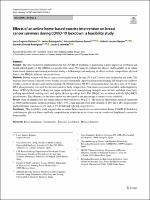Por favor, use este identificador para citar o enlazar este ítem:
https://repositorio.usj.es/handle/123456789/959
| Título : | Effects of an online home‑based exercise intervention on breast cancer survivors during COVID‑19 lockdown: a feasibility study |
| Autor: | Sagarra-Romero, Lucía


Butragueño, Javier 
Gomez-Bruton, Alejandro 


Lozano-Berges, Gabriel 


Vicente-Rodríguez, Germán 


Morales, Javier S. 


|
| Palabras clave : | Breast neoplasms; Coronavirus; Exercise; Lockdown; Physical function |
| Fecha de publicación: | 26-abr-2022 |
| Editorial : | Springer |
| Citación : | Sagarra-Romero, L., Butragueño, J., Gomez-Bruton, A. et al. Effects of an online home-based exercise intervention on breast cancer survivors during COVID-19 lockdown: a feasibility study. Support Care Cancer 30, 6287–6297 (2022). https://doi.org/10.1007/s00520-022-07069-4 |
| Resumen : | Abstract Purpose The strict lockdown implemented due the COVID-19 pandemic is generating a great impact on wellbeing and health-related quality of life (HRQoL) in people with cancer. We aimed to evaluate the efficacy and feasibility of an online home-based exercise intervention performed during a lockdown period analysing its effects on body composition, physical fitness, and HRQoL in breast cancer survivors. Methods Fifteen women with breast cancer receiving hormonal therapy (55.5 ± 6.7 years) were included in the study. The exercise intervention consisted of two weekly sessions of remotely supervised functional training (60 min per day) and two weekly sessions of unsupervised aerobic training (20–30 min/session; 60–85% of maximum heart rate) for a total of 16 weeks. DXA absorptiometry was used for the assessment of body composition. Functional assessment included cardiorespiratory fitness (CRF) by Rockport walking test, upper and lower body strength (grip strength, arm curl test, and chair stand test), walking speed (brisk walking test), and agility (8-foot up-and-go test). The HRQoL was evaluated with the QLQ-BR23 questionnaire. The adherence to the intervention was measured as the percentage of online classes attended. Results Rate of adherence for the online exercise intervention was 90 ± 17%. The exercise intervention induced significant (p < 0.05) improvements in physical fitness: CRF (+ 9%), right arm and lower limb strength (+ 10% and + 18%, respectively) and lower limbs lean mass (+ 2% and + 3.5% for left and right leg, respectively). Conclusion This feasibility study suggests that an online home-based exercise intervention during COVID-19 lockdown could improve physical fitness and body composition in breast cancer survivors even in a context of heightened concern for future health. |
| URI : | https://repositorio.usj.es/handle/123456789/959 |
| ISSN : | 1433-7339 |
| Aparece en las colecciones: | Artículos de revistas |
Ficheros en este ítem:
| Fichero | Descripción | Tamaño | Formato | |
|---|---|---|---|---|
| Effects of an online home‑based exercise intervention on breast.pdf | 1,15 MB | Adobe PDF |  Visualizar/Abrir |
Los ítems de USJ están protegidos por copyright, con todos los derechos reservados, a menos que se indique lo contrario.
